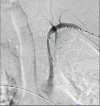Successful endovascular treatment of post-traumatic subclavian arteriovenous fistula
- PMID: 39678484
- PMCID: PMC11645533
- DOI: 10.1093/jscr/rjae764
Successful endovascular treatment of post-traumatic subclavian arteriovenous fistula
Abstract
Subclavian arteriovenous fistulas (AVFs) are rare entities, mostly reported as a result of traumatic and iatrogenic injuries. In the literature, congenital subclavian AVFs are also presented. Diagnosis of traumatic AVF may present challenges given the variable clinical presentation, varying location, and difficulty to locate on imaging. If left untreated, it can lead to high-output heart failure. This underlies the importance of understanding the nature of the disease, timely diagnosis, and treatment in order to prevent increased morbidity and mortality. We report a case of a patient having a traumatic left subclavian AVF formation after clavicle and rib surgery, which was successfully treated with a covered stent.
Keywords: arteriovenous fistula; endovascular repair; subclavian artery; traumatic fistula.
Published by Oxford University Press and JSCR Publishing Ltd. © The Author(s) 2024.
Conflict of interest statement
The authors declare that they have no known competing financial interests or personal relationships that could have appeared to influence the work reported in this article.
Figures





References
-
- Silva RM, Cury RC, Brito CJ. Fístulas arteriovenosas traumáticas. In: Brito CJ (ed.). Cirurgia vascular, 3rd edn. Rio de Janeiro: Revinter, 2014, 1741–57.
Publication types
LinkOut - more resources
Full Text Sources

